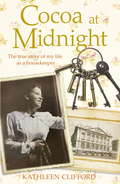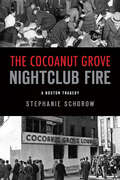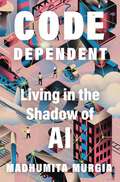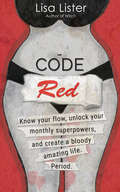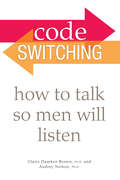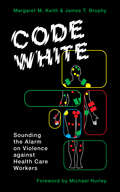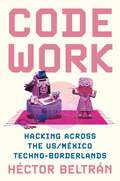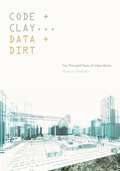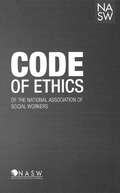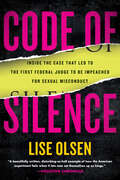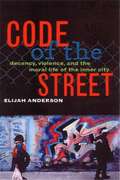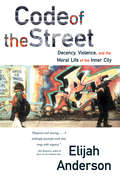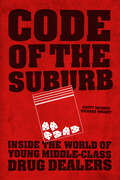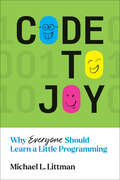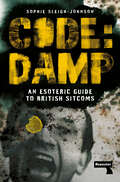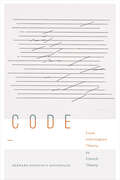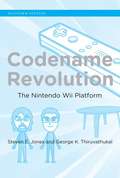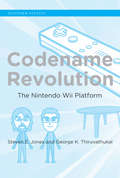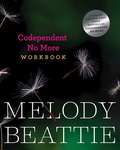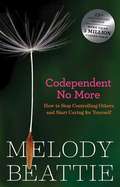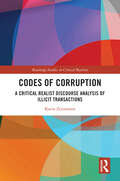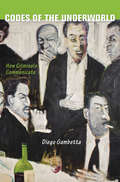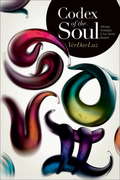- Table View
- List View
Cocoa at Midnight: The real life story of my time as a housekeeper
by Tom Quinn Kathleen CliffordKathleen Clifford was born in 1909. Her family lived in a tiny flat near Paddington Station and her earliest memories were of the smell of horses and the shrill whistle of steam trains. For a girl from the slums there was only really one option once school was over - a life in service. <P><P>She started work on 1925 as a lowly kitchen maid in the London home of Lady Diana Spencer's family. Here she heard tales of the Earl's propensity for setting fire to himself, as well as enjoying the servant's gossip about who was sleeping with whom. <P> The Spencers were just the first in a line of eccentric families for whom she worked during a career that lasted more than thirty years and took her from a London palace to remote medieval estates. But despite long hours, amorous butlers and mad employers, Kathleen always kept her sense of humour and knew how to have fun.
Cocoa at Midnight: The real life story of my time as a housekeeper
by Tom QuinnKathleen Clifford was born in 1909. Her family lived in a tiny flat near Paddington Station and her earliest memories were of the smell of horses and the shrill whistle of steam trains. For a girl from the slums there was only really one option once school was over - a life in service. She started work on 1925 as a lowly kitchen maid in the London home of Lady Diana Spencer's family. Here she heard tales of the Earl's propensity for setting fire to himself, as well as enjoying the servant's gossip about who was sleeping with whom. The Spencers were just the first in a line of eccentric families for whom she worked during a career that lasted more than thirty earrs and took her from a London palace to remote medieval estates. But despite long hours, amorous butlers and mad employers, Kathleen always kept her sense of humour and knew how to have fun. On one occasion she was almost caught in bed with her boyfriend who had to jump out of the window and run down the drive in his underwear to escape the local bobby.
Cocoanut Grove Nightclub Fire, The: A Boston Tragedy (Disaster)
by Stephanie SchorowOn November 28, 1942, fire roared through Boston's famed Cocoanut Grove nightclub during what was supposed to be a high-spirited Saturday night. By midnight, more than five hundred people were dead, dying, or maimed for life. Local author Stephanie Schorow probes the club's history, the circumstances leading to the fire, and the tragedy's lingering impact. The inferno reached deep into the city's social structure--its politics, medical care, law enforcement, and religious life--and touched nearly everyone in the Boston area, even those who had never set foot in the club. In this newly updated and revised edition, Schorow has added new information, photographs, interviews and insights on the worst nightclub fire in American history.
Code Dependent: Living in the Shadow of AI
by Madhumita MurgiaShortlisted for the Women’s Prize for Non-FictionA riveting story of what it means to be human in a world changed by artificial intelligence, revealing the perils and inequities of our growing reliance on automated decision-makingOn the surface, a British poet, an UberEats courier in Pittsburgh, an Indian doctor, and a Chinese activist in exile have nothing in common. But they are in fact linked by a profound common experience—unexpected encounters with artificial intelligence. In Code Dependent, Murgia shows how automated systems are reshaping our lives all over the world, from technology that marks children as future criminals, to an app that is helping to give diagnoses to a remote tribal community. AI has already infiltrated our day-to-day, through language-generating chatbots like ChatGPT and social media. But it’s also affecting us in more insidious ways. It touches everything from our interpersonal relationships, to our kids’ education, work, finances, public services, and even our human rights.By highlighting the voices of ordinary people in places far removed from the cozy enclave of Silicon Valley, Code Dependent explores the impact of a set of powerful, flawed, and often-exploitative technologies on individuals, communities, and our wider society. Murgia exposes how AI can strip away our collective and individual sense of agency, and shatter our illusion of free will. The ways in which algorithms and their effects are governed over the coming years will profoundly impact us all. Yet we can’t agree on a common path forward. We cannot decide what preferences and morals we want to encode in these entities—or what controls we may want to impose on them. And thus, we are collectively relinquishing our moral authority to machines.In Code Dependent, Murgia not only sheds light on this chilling phenomenon, but also charts a path of resistance. AI is already changing what it means to be human, in ways large and small, and Murgia reveals what could happen if we fail to reclaim our humanity.
Code Red: Know Your Flow, Unlock Your Superpowers, and Create a Bloody Amazing Life. Period.
by Lisa ListerYour period has power. Embrace your natural cycle, work with your hormones and connect to the innate feminine wisdom of your menstrual cycle.Your period is way more than PMS, carb cravings and lady rage - it's actually a 4-part lady code that, once cracked, will uncover a series of monthly superpowers that can be used to enhance your relationships with others, build a better business, have incredible sex and create a 'bloody' amazing life.Code Red, from the Creatrix of www.thesassyshe.com, Lisa Lister, is a call to action. A rallying cry that dares you to explore, navigate and most importantly, love your lady landscape.You'll learn how to live and work in complete alignment with the rhythms of nature, the moon and your menstrual cycle, be inspired by insights from Wise + Wild Women like Meggan Watterson, Alexandra Pope and Uma Dinsmore Tuli, and gain access to easy-to-follow strategies and SHE Flow yoga practices. You'll be invited to connect with your true nature as a woman, tap into the transformational power of your innate feminine wisdom and use your menstrual cycle as an ever-unfolding map to crack your lady code.
Code Switching: How to Talk So Men Will Listen
by Audrey Nelson Claire Damken BrownMars and Venus head to work... Day-to-day, face-to-face workplace communication between men and women is often dysfunctional because each gender employs different speech patterns. When careers and paychecks are on the line, clear communication is crucial-from the mailroom to the boardroom. Code Switching explains what to say, how to say it, how to be taken seriously, and how to act while speaking with the opposite sex for maximum effectiveness in the workplace. Included are: How men and women manage conversation, and the value of "chitchat" prior to a meeting. How men use language to impart information and women use language to build or indicate relationship. How men use e-mail to emphasize control while women use it to share and build rapport. How women can use language to build their credibility. How humor is used as a power play, to build territory, or to exclude others. How gender talk creates and shapes work relationships.
Code White: Sounding the Alarm on Violence against Health Care Workers
by James T. Brophy Margaret M. KeithWhen health care workers call a Code White, it’s an emergency response for a violent incident: a call for help. But it’s one that goes unanswered in hospitals, clinics, and long-term care homes across the country. Code White exposes a shocking epidemic of violence that’s hidden in plain sight, one in which workers are bruised, battered, assaulted, and demeaned, but carry on in silence, with little recourse or support. Researchers Margaret M. Keith and James T. Brophy lay bare the stories of over one hundred nurses and personal support workers, aides and porters, clerical workers and cleaners. The nightmarish experiences they relate are not one-off incidents, but symptoms of deep systemic flaws that have transformed health care into one of the most dangerous occupational sectors in Canada. The same questions echo in the wake of each and every brutal encounter: Is violence and trauma really just “part of the job”? Why is this going underreported and unchecked? What needs to be done, and how?
Code Work: Hacking across the US/México Techno-Borderlands (Princeton Studies in Culture and Technology #38)
by Héctor BeltránHow Mexican and Latinx hackers apply concepts from coding to their lived experiencesIn Code Work, Héctor Beltrán examines Mexican and Latinx coders&’ personal strategies of self-making as they navigate a transnational economy of tech work. Beltrán shows how these hackers apply concepts from the code worlds to their lived experiences, deploying batches, loose coupling, iterative processing (looping), hacking, prototyping, and full-stack development in their daily social interactions—at home, in the workplace, on the dating scene, and in their understanding of the economy, culture, and geopolitics. Merging ethnographic analysis with systems thinking, he draws on his eight years of research in México and the United States—during which he participated in and observed hackathons, hacker schools, and tech entrepreneurship conferences—to unpack the conundrums faced by workers in a tech economy that stretches from villages in rural México to Silicon Valley.Beltrán chronicles the tension between the transformative promise of hacking—the idea that coding will reconfigure the boundaries of race, ethnicity, class, and gender—and the reality of a neoliberal capitalist economy divided and structured by the US/México border. Young hackers, many of whom approach coding in a spirit of playfulness and exploration, are encouraged to appropriate the discourses of flexibility and self-management even as they remain outside formal employment. Beltrán explores the ways that &“innovative culture&” is seen as central in curing México&’s social ills, showing that when innovation is linked to technological development, other kinds of development are neglected. Beltrán&’s highly original, wide-ranging analysis uniquely connects technology studies, the anthropology of capitalism, and Latinx and Latin American studies.
Code and Clay, Data and Dirt: Five Thousand Years of Urban Media
by Shannon MatternFor years, pundits have trumpeted the earthshattering changes that big data and smart networks will soon bring to our cities. But what if cities have long been built for intelligence, maybe for millennia? In Code and Clay, Data and Dirt Shannon Mattern advances the provocative argument that our urban spaces have been &“smart&” and mediated for thousands of years.Offering powerful new ways of thinking about our cities, Code and Clay, Data and Dirt goes far beyond the standard historical concepts of origins, development, revolutions, and the accomplishments of an elite few. Mattern shows that in their architecture, laws, street layouts, and civic knowledge—and through technologies including the telephone, telegraph, radio, printing, writing, and even the human voice—cities have long negotiated a rich exchange between analog and digital, code and clay, data and dirt, ether and ore. Mattern&’s vivid prose takes readers through a historically and geographically broad range of stories, scenes, and locations, synthesizing a new narrative for our urban spaces. Taking media archaeology to the city&’s streets, Code and Clay, Data and Dirt reveals new ways to write our urban, media, and cultural histories.
Code of Ethics of the National Association of Social Workers
by National Association of Social WorkersThe NASW Code of Ethics is intended to serve as a guide to the everyday professional conduct of social workers. This Code includes four sections. The first section, "Preamble," summarizes the social work profession's mission and core values. The second section, "Purpose of the NASW Code of Ethics," provides an overview of the Code's main functions and a brief guide for dealing with ethical issues or dilemmas in social work practice. The third section, "Ethical Principles," presents broad ethical principles, based on social work's core values, that inform social work practice. The final section, "Ethical Standards," includes specific ethical standards to guide social workers' conduct and to provide a basis for adjudication.
Code of Silence: Sexual Misconduct by Federal Judges, the Secret System That Protects Them, and the Women Who Blew the Whistle
by Lise OlsenIn the age of #MeToo, learn how brave whistleblowers have dared to lift the federal court&’s veil of secrecy to expose powerful judges who appear to defy laws they have sworn to uphold. Code of Silence tells the story of federal court employee Cathy McBroom, who had to flee her job as a case manager in Galveston, Texas, after enduring years of sexual harassment and assault by her boss—US District Judge Samuel Kent. Following a decade of firsthand reporting at the Houston Chronicle, investigative reporter Lise Olsen charts McBroom&’s assault and the aftermath, when McBroom was thrust into the role of whistleblower to denounce a federal judge.What Olsen discovered by investigating McBroom&’s story and other federal judicial misconduct matters nationwide was shocking. With the help of other federal judges, Kent was being protected by a secretive court system that has long tolerated or ignored complaints about corruption, sexism, and sexual misconduct—enabling him to remain in office for years. Other powerful judges accused of judicial misconduct were never investigated and remain in power or retired with full pay, such as US Circuit Judge Alex Kozinski and Kozinski&’s mentee, Brett Kavanaugh.McBroom&’s ultimate triumph is a rare story of redemption and victory as Judge Kent became the first and only federal judge to be impeached for sexual misconduct. Olsen also weaves in narratives of other brave women across the country who, at great personal risk, have reported federal judges to reveal how sexual harassment and assault occur elsewhere inside the federal court system. The accounts of the women and their allies who are still fighting for reforms are moving, intimate, and inspiring—including whistleblowers and law professors like Leah Litman, Emily Murphy, and novelist Heidi Bond, who emerged to denounce Kozinski in 2017. A larger group of women—and men—banded together to form a group called Law Clerks for Accountability, which is continuing to push for more reforms to the courts&’ secretive complaint review system.Code of Silence also reveals the role the press plays in holding systems of power in check. Kent would not have been charged had it not been for Olsen&’s reporting and the Houston Chronicle&’s commitment to the story.
Code of the Street: Decency, Violence and the Moral Life of the Inner City
by Elijah AndersonThis incisive book examines the code as a response to the lack of jobs that pay a living wage, to the stigma of race, to rampant drug use, to alienation and lack of hope.
Code of the Street: Decency, Violence, and the Moral Life of the Inner City
by Elijah AndersonUnsparing and important. . . . An informative, clearheaded and sobering book.--Jonathan Yardley, Washington Post (1999 Critic's Choice) Inner-city black America is often stereotyped as a place of random violence, but in fact, violence in the inner city is regulated through an informal but well-known code of the street. This unwritten set of rules--based largely on an individual's ability to command respect--is a powerful and pervasive form of etiquette, governing the way in which people learn to negotiate public spaces. Elijah Anderson's incisive book delineates the code and examines it as a response to the lack of jobs that pay a living wage, to the stigma of race, to rampant drug use, to alienation and lack of hope.
Code of the Suburb: Inside the World of Young Middle-Class Drug Dealers (Fieldwork Encounters and Discoveries)
by Richard Wright Scott JacquesWhen we think about young people dealing drugs, we tend to picture it happening on urban streets, in disadvantaged, crime-ridden neighborhoods. But drugs are used everywhere--even in upscale suburbs and top-tier high schools--and teenage users in the suburbs tend to buy drugs from their peers, dealers who have their own culture and code, distinct from their urban counterparts. In Code of the Suburb, Scott Jacques and Richard Wright offer a fascinating ethnography of the culture of suburban drug dealers. Drawing on fieldwork among teens in a wealthy suburb of Atlanta, they carefully parse the complicated code that governs relationships among buyers, sellers, police, and other suburbanites. That code differs from the one followed by urban drug dealers in one crucial respect: whereas urban drug dealers see violent vengeance as crucial to status and security, the opposite is true for their suburban counterparts. As Jacques and Wright show, suburban drug dealers accord status to deliberate avoidance of conflict, which helps keep their drug markets more peaceful--and, consequently, less likely to be noticed by law enforcement. Offering new insight into both the little-studied area of suburban drug dealing, and, by extension, the more familiar urban variety, Code of the Suburb will be of interest to scholars and policy makers alike.
Code to Joy: Why Everyone Should Learn a Little Programming
by Michael L. LittmanHow we can get more joy from our machines by telling them what our hearts desire.In this informative, accessible, and very funny book, Michael L. Littman inspires readers to learn how to tell machines what to do for us. Rather than give in to the fear that computers will steal our jobs, spy on us and control what we buy and whom we vote for, we can improve our relationship with them just by learning basic programming skills. Our devices will help us, Littman writes, if we can say what we want in a way they can understand.Each chapter of the book focuses on a particular element of what can be said, providing examples of how we use similar communication in our daily interactions with people. Littman offers ways readers can experiment with these ideas right away, using publicly available systems that might also make us more productive as a welcome side effect. Each chapter also reflects on how the use of these programming components can be expedited by machine learning. With humor and teacherly guidance, Code to Joy brings into view a future where programming is like reading—something everyone can learn.
Code: An Esoteric Guide to British Sitcoms
by Sophie Sleigh-JohnsonAn alternative occult and esoteric history of England told through one of its most popular cultural forms: the comedy sitcom.Code: Damp is a sometimes-comedic field report that charts an esoteric code hidden within the twin poles of 1970s sitcoms Rising Damp and The Fall and Rise of Reginald Perrin. Outlining how past cultural patterns condensate and repeat through technology, time is shown to be a damp condensation seeping through the centuries and out onto the telly. Interspersed with the author&’s own photographs, prints, Holsten Pils cans, local newspaper entries and carrier bags, as well as a whole host of other characters, the work seems an antiquarian&’s conceit that takes time travel as a metaphoric methodology. This is not media studies; more an allegory of all reality as (tele)visual recorded history, excavating the strata of haunted technology from which the fragile band of code comprising our sense of time is briefly emitted. Drawing connections between incidents of ancient and popular culture, from Mark E. Smith&’s lyric— &“They say damp records the past&”—to Rising Damp&’s (meta)physical structure of decay, the book finds damp&’s temporal power manifest in everything from alchemy, mysticism, and parish folklore to pulp, Time Team, darts, the local newspaper and, of course, the sitcom. Merging the vast with the parochial, the occult with the comedic, Code: Damp tunes into the weird demands of damp as a time-traveling material at the intersections of comedy, myth and technology, taking all three as serious resources to better (dis)orient the ground we stand on.
Code: From Information Theory to French Theory (Sign, Storage, Transmission)
by Bernard Dionysius GeogheganIn Code Bernard Dionysius Geoghegan reconstructs how Progressive Era technocracy as well as crises of industrial democracy and colonialism shaped early accounts of cybernetics and digital media by theorists including Norbert Wiener, Warren Weaver, Margaret Mead, Gregory Bateson, Claude Lévi-Strauss, Roman Jakobson, Jacques Lacan, Roland Barthes, and Luce Irigaray. His analysis casts light on how media-practical research forged common epistemic cause in programs that stretched from 1930s interwar computing at MIT and eugenics to the proliferation of seminars and laboratories in 1960s Paris. This mobilization ushered forth new fields of study such as structural anthropology, family therapy, and literary semiology while forming enduring intellectual affinities between the humanities and informatics. With Code, Geoghegan offers a new history of French theory and the digital humanities as transcontinental and political endeavors linking interwar colonial ethnography in Dutch Bali to French sciences in the throes of Cold War-era decolonization and modernization.
Codename Revolution
by Steven Jones George ThiruvathukalThe Nintendo Wii, introduced in 2006, helped usher in a moment of retro-reinvention in video game play. This hugely popular console system, codenamed Revolution during development, signaled a turn away from fully immersive, time-consuming MMORPGs or forty-hour FPS games and back toward family fun in the living room. Players using the wireless motion-sensitive controller (the Wii Remote, or "Wiimote") play with their whole bodies, waving, swinging, swaying. The mimetic interface shifts attention from what's on the screen to what's happening in physical space. This book describes the Wii's impact in technological, social, and cultural terms, examining the Wii as a system of interrelated hardware and software that was consciously designed to promote social play in physical space. Each chapter of Codename Revolution focuses on a major component of the Wii as a platform: the console itself, designed to be low-powered and nimble; the iconic Wii Remote; Wii Fit Plus, and its controller, the Wii Balance Board; the Wii Channels interface and Nintendo's distribution system; and the Wii as a social platform that not only affords multiplayer options but also encourages social interaction in shared physical space. Finally, the authors connect the Wii's revolution in mimetic interface gaming--which eventually led to the release of Sony's Move and Microsoft's Kinect--to some of the economic and technological conditions that influence the possibility of making something new in this arena of computing and culture.
Codename Revolution: The Nintendo Wii Platform (Platform Studies)
by Steven E. Jones George K. ThiruvathukalNintendo's hugely popular and influential video game console system considered as technological device and social phenomenon.The Nintendo Wii, introduced in 2006, helped usher in a moment of retro-reinvention in video game play. This hugely popular console system, codenamed Revolution during development, signaled a turn away from fully immersive, time-consuming MMORPGs or forty-hour FPS games and back toward family fun in the living room. Players using the wireless motion-sensitive controller (the Wii Remote, or “Wiimote”) play with their whole bodies, waving, swinging, swaying. The mimetic interface shifts attention from what's on the screen to what's happening in physical space. This book describes the Wii's impact in technological, social, and cultural terms, examining the Wii as a system of interrelated hardware and software that was consciously designed to promote social play in physical space.Each chapter of Codename Revolution focuses on a major component of the Wii as a platform: the console itself, designed to be low-powered and nimble; the iconic Wii Remote; Wii Fit Plus, and its controller, the Wii Balance Board; the Wii Channels interface and Nintendo's distribution system; and the Wii as a social platform that not only affords multiplayer options but also encourages social interaction in shared physical space. Finally, the authors connect the Wii's revolution in mimetic interface gaming—which eventually led to the release of Sony's Move and Microsoft's Kinect—to some of the economic and technological conditions that influence the possibility of making something new in this arena of computing and culture.
Codependent No More Workbook
by Melody BeattieThis highly anticipated workbook will help readers put the principles from Melody Beattie's international best seller Codependent No More into action in their own lives.This highly anticipated workbook will help readers put the principles from Melody Beattie's international best seller Codependent No More into action in their own lives.The Codependent No More Workbook was designed for Beattie fans spanning the generations, as well as for those who may not yet even understand the meaning and impact of their codependency. In this accessible and engaging workbook, Beattie uses her trademark down-to-earth style to offer readers a Twelve Step, interactive program to stop obsessing about others by developing the insight, strength, and resilience to start taking care of themselves.Through hands-on guided journaling, exercises, and self-tests, readers will learn to integrate the time-tested concepts outlined in Codependent No More into their daily lives bysetting and enforcing healthy limitsdeveloping a support system through healthy relationships with others and a higher powerexperiencing genuine love and forgivenessletting go and detaching from others' harmful behaviorsWhether fixated on a loved one with depression, an addiction, an eating disorder, or other self-destructive behaviors, or someone who makes unhealthy decisions, this book offers the practical means to plot a comprehensive, personalized path to hope, healing, and the freedom to be your own best self.
Codependent No More: How to Stop Controlling Others and Start Caring for Yourself
by Melody BeattieThe healing touchstone of millions, this modern classic by one of America's best-loved and most inspirational authors holds the key to understanding codependency and to unlocking its stultifying hold on your life.Is someone else's problem your problem? If, like so many others, you've lost sight of your own life in the drama of tending to someone else's, you may be codependent--and you may find yourself in this book--Codependent No More.The healing touchstone of millions, this modern classic by one of America's best-loved and most inspirational authors holds the key to understanding codependency and to unlocking its stultifying hold on your life.With instructive life stories, personal reflections, exercises, and self-tests, Codependent No More is a simple, straightforward, readable map of the perplexing world of codependency--charting the path to freedom and a lifetime of healing, hope, and happiness.Melody Beattie is the author of Beyond Codependency, The Language of Letting Go, Stop Being Mean to Yourself, The Codependent No More Workbook and Playing It by Heart.
Coders: The Making of a New Tribe and the Remaking of the World
by Clive ThompsonHello, world.Facebook's algorithms shaping the news. Self-driving cars roaming the streets. Revolution on Twitter and romance on Tinder. We live in a world constructed of code--and coders are the ones who built it for us. From acclaimed tech writer Clive Thompson comes a brilliant anthropological reckoning with the most powerful tribe in the world today, computer programmers, in a book that interrogates who they are, how they think, what qualifies as greatness in their world, and what should give us pause. They are the most quietly influential people on the planet, and Coders shines a light on their culture.In pop culture and media, the people who create the code that rules our world are regularly portrayed in hackneyed, simplified terms, as ciphers in hoodies. Thompson goes far deeper, dramatizing the psychology of the invisible architects of the culture, exploring their passions and their values, as well as their messy history. In nuanced portraits, Coders takes us close to some of the great programmers of our time, including the creators of Facebook's News Feed, Instagram, Google's cutting-edge AI, and more. Speaking to everyone from revered "10X" elites to neophytes, back-end engineers and front-end designers, Thompson explores the distinctive psychology of this vocation--which combines a love of logic, an obsession with efficiency, the joy of puzzle-solving, and a superhuman tolerance for mind-bending frustration. Along the way, Coders thoughtfully ponders the morality and politics of code, including its implications for civic life and the economy. Programmers shape our everyday behavior: When they make something easy to do, we do more of it. When they make it hard or impossible, we do less of it. Thompson wrestles with the major controversies of our era, from the "disruption" fetish of Silicon Valley to the struggle for inclusion by marginalized groups.In his accessible, erudite style, Thompson unpacks the surprising history of the field, beginning with the first coders -- brilliant and pioneering women, who, despite crafting some of the earliest personal computers and programming languages, were later written out of history. Coders introduces modern crypto-hackers fighting for your privacy, AI engineers building eerie new forms of machine cognition, teenage girls losing sleep at 24/7 hackathons, and unemployed Kentucky coal-miners learning a new career. At the same time, the book deftly illustrates how programming has become a marvelous new art form--a source of delight and creativity, not merely danger. To get as close to his subject as possible, Thompson picks up the thread of his own long-abandoned coding skills as he reckons, in his signature, highly personal style, with what superb programming looks like. To understand the world today, we need to understand code and its consequences. With Coders, Thompson gives a definitive look into the heart of the machine.
Codes of Corruption: A Critical Realist Discourse Analysis of Illicit Transactions (Routledge Studies in Critical Realism)
by Karin ZotzmannCorruption is expanding internationally and so are strategic accusations of others being corrupt. It has become quite common for some politicians and their supporters to make false accusations of corruption against opponents in order to win power. A precise understanding of the phenomenon is therefore urgently needed for economic and political governance. The phenomenon has so far been investigated from the disciplines of sociology, criminology, politics, and economics, but rarely with a focus on the actual negotiation of corrupt deals. This is mainly because access to these illegal, often discursively mediated, practices is highly complicated. Empirical studies have therefore either focused quantitatively on the number of cases that came to light or on perceptions of and attitudes towards the phenomenon.Codes of Corruption attempts to fill this gap. It draws on a corpus of videos and audio recordings from Mexico secretly recorded by individuals who were present at the time and later uploaded to a public streaming platform. This corpus was analyzed through a variety of analytical tools to show the interactional and discursive work participants engage in to come to an agreement and, at the same time, the structural configurations that enabled, constrained, and motivated the participants. To capture these multidimensional causal configurations and avoid the pitfalls of reductionism, the theoretical and methodological framework adopted in this research is based on the philosophy of Critical Realism.Through this innovative approach, the book aims to contribute to debates and emerging research agendas in the study of corruption and thus to further the conceptualization of the phenomenon, its causes, and potential remedies. Its results will be of interest to researchers in the above-mentioned disciplines as well as to those working in Critical Discourse Analysis, Critical Realism, Interactional Sociolinguistics, and Pragmatics. Codes of Corruption will also be of interest to a wider audience of governmental and non-governmental institutions that engage in the design of anti-corruption strategies, training, and education.
Codes of the Underworld: How Criminals Communicate
by Diego GambettaThe signs and signals of criminal communicationHow do criminals communicate with each other? Unlike the rest of us, people planning crimes can't freely advertise their goods and services, nor can they rely on formal institutions to settle disputes and certify quality. They face uniquely intense dilemmas as they grapple with the basic problems of whom to trust, how to make themselves trusted, and how to handle information without being detected by rivals or police. In this book, one of the world's leading scholars of the mafia ranges from ancient Rome to the gangs of modern Japan, from the prisons of Western countries to terrorist and pedophile rings, to explain how despite these constraints, many criminals successfully stay in business.Diego Gambetta shows that as villains balance the lure of criminal reward against the fear of dire punishment, they are inspired to unexpected feats of subtlety and ingenuity in communication. He uncovers the logic of the often bizarre ways in which inveterate and occasional criminals solve their dilemmas, such as why the tattoos and scars etched on a criminal's body function as lines on a professional résumé, why inmates resort to violence to establish their position in the prison pecking order, and why mobsters are partial to nicknames and imitate the behavior they see in mafia movies. Even deliberate self-harm and the disclosure of their crimes are strategically employed by criminals to convey important messages.By deciphering how criminals signal to each other in a lawless universe, this gruesomely entertaining and incisive book provides a quantum leap in our ability to make sense of their actions.
Codex of the Soul
by VerdarluzIn Codex of the Soul, VerDarLuz guides the reader through the multifaceted nature of astrology, focusing on its practical use and spiritual nature. Providing practical and effective techniques for experiencing your birthchart, VerDarLuz explores the planets as an evolutionary force within the soul, seeking to be awakened and realized at certain regular intervals.In part one, VerDarLuz provides a thorough description of the historical, metaphysical, and cosmological foundations of astrology, followed by an overview of a wide-ranging set of cosmologies related to astrology, from the Greek and Roman pantheons to Hindu scriptures, sacred geometry, and archetypes. Part two probes the deeper meanings of planets, signs, houses, and aspects and introduces methods of chart interpretation. Part three explores the connection between planetary cycles and personal rites of passage, helping readers create their own "life reviews" and become better equipped to meet pivotal life changes (such as the Saturn return) as well as the rites of passage of partners and children. Utilizing famous biographies and tools of practical magic, Codex of the Soul paints a mythical map of the entirety of the human journey, offering tools for harmonizing with all of life's initiations.From the Trade Paperback edition.
